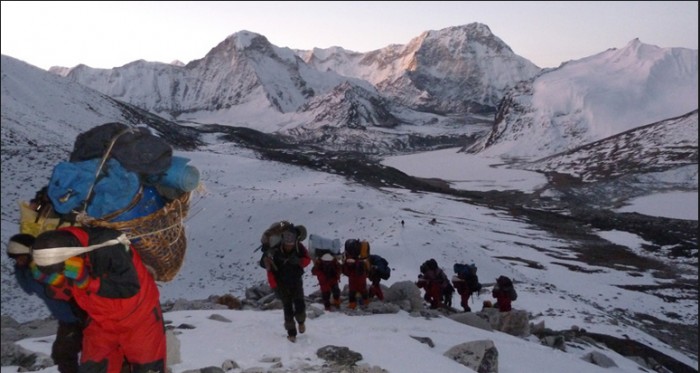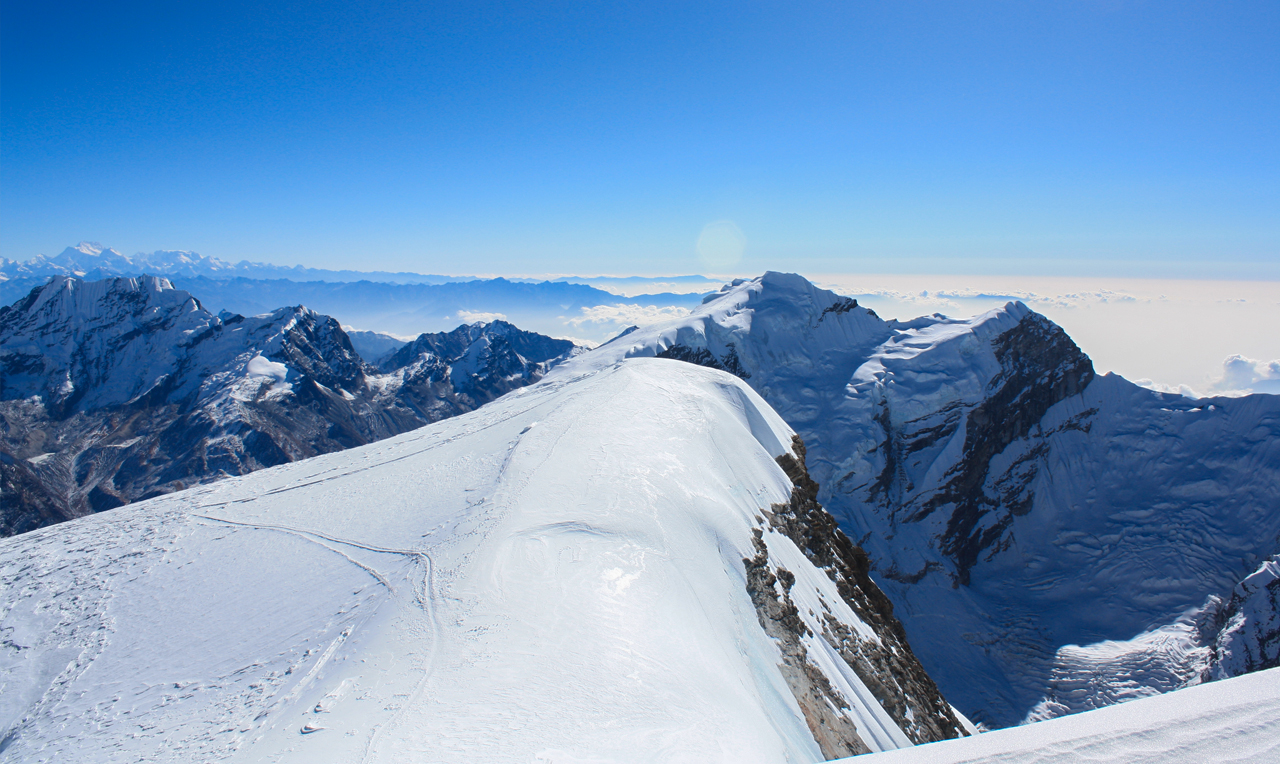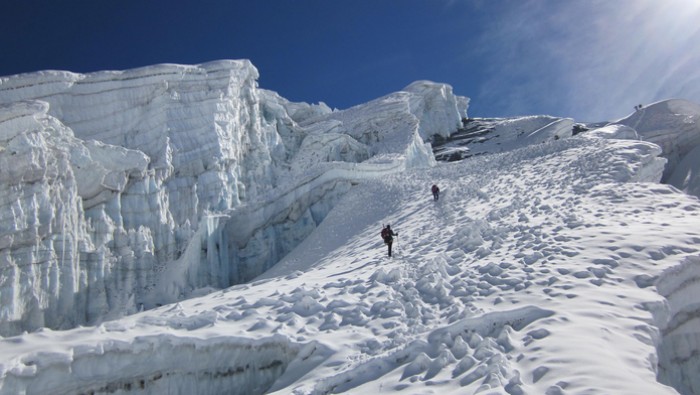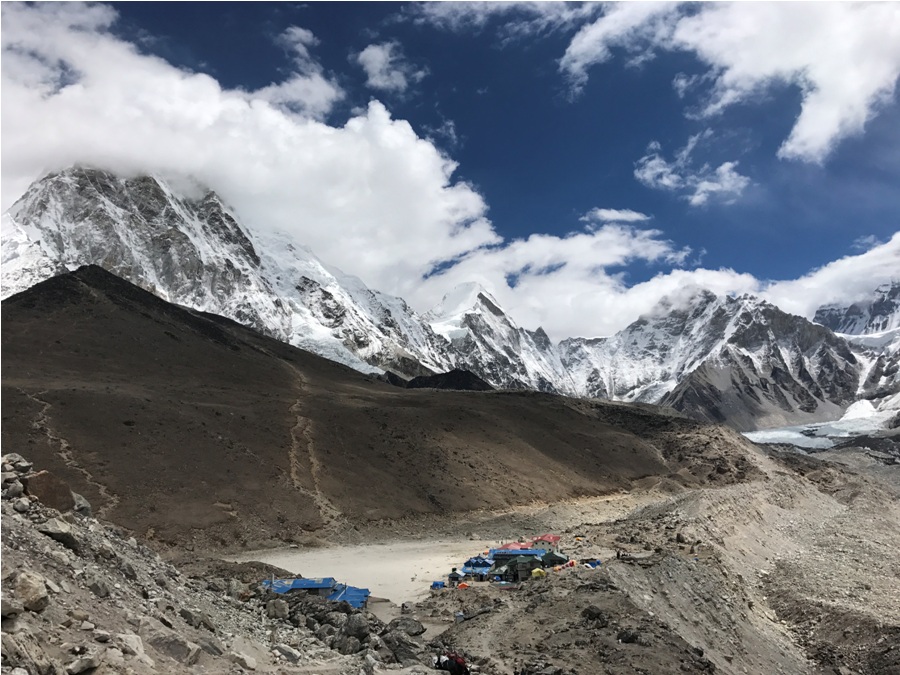Mera Peak and Island Peak Climbing – 23 Days

Trip Overview
Trip Highlights
- Break out from Kathmandu to Lukla (40 mins) by air flight.
- These peaks are the precedent of natural purity and natural peril.
- Everest,Lhotse,Kanchenjunga,Makalu and Cho Oyu above 8000 m can be watch and ward.
- A bit of Technic of climbing and spunky mountaineers can hold the triumph.
- Challenging peak climbing so relevant for adventurous seekers.
- Most essential gears and using knowledge is predominant.
- Sherpa guide who is accustomed with every nooks and carnies will handle the routes.
- March-May and September- December is far more well-suited months to start.
Venture into the heart of the Himalayas with Skyline Treks & Expedition’s Mera Peak and Island Peak Climbing, an exhilarating journey that combines the ascent of two iconic trekking peaks: Mera Peak (6,476m), Nepal’s highest trekking peak, and Island Peak (Imja Tse, 6,189m). This 21-day adventure begins with a thrilling flight to Lukla (2,715m) and takes you through the remote Hinku Valley to Mera Peak, followed by a challenging traverse over the Amphu Laptsa (5,845m) to reach Island Peak in the Khumbu Valley. With stunning views of Mount Everest (8,848m), Lhotse, Makalu, Cho Oyu, and Ama Dablam, this expedition is perfect for fit adventurers seeking a blend of high-altitude trekking, technical climbing, and cultural discovery in the serene landscapes of Nepal’s Everest region.
The journey to Mera Peak offers an off-the-beaten-path experience through the tranquil Makalu Barun National Park, where you’ll trek past lush forests, remote Sherpa villages, and glistening glaciers. Mera Peak, first climbed in 1953 by Col. Jimmy Roberts and Sen Tenzing, is a moderately challenging climb requiring basic mountaineering skills like using crampons and ice axes, with a rewarding summit view of five of the world’s highest peaks. After summiting, you’ll cross the technical Amphu Lapcha Pass, a highlight for thrill-seekers, before descending into the vibrant Khumbu Valley to reach Island Peak. Named by Eric Shipton’s 1953 expedition for its island-like appearance in a sea of ice, Island Peak involves steeper ice slopes and fixed ropes, offering a more technical climb with breathtaking vistas of Ama Dablam and Nuptse.
Skyline Treks & Expedition, with over 25 years of experience, ensures a safe and unforgettable adventure. Our expert Sherpa guides, many with multiple summit successes, provide pre-climb training at Mera and Island Peak base camps (5,300m and 5,087m, respectively), teaching skills like rope fixing and ice climbing to boost your confidence. The itinerary includes acclimatization days at Thuli Kharka (4,160m) and Khare (5,099m) to prevent altitude sickness, crucial at altitudes exceeding 6,000m where oxygen levels are low. With only about 300 groups attempting these peaks annually, you’ll experience the solitude and grandeur of the Himalayas, supported by cozy teahouse and tented camp accommodations, hearty meals, and all necessary permits.
This expedition is a test of physical and mental endurance, covering approximately 150 km over 21 days, with daily treks of 5-8 hours and summit days lasting up to 12 hours. The best seasons are spring (March-May) and autumn (September-December), offering clear skies and daytime temperatures from 0°C to 15°C. You’ll immerse yourself in Sherpa culture, passing through villages like Kothe and Dingboche, and explore the biodiversity of Sagarmatha and Makalu Barun National Parks, home to rare species like red pandas and Himalayan thar. Whether you’re a beginner with basic climbing skills or an experienced mountaineer, Skyline’s meticulous planning ensures a high success rate for this bucket-list adventure.
From the serene trails of the Hinku Valley to the adrenaline-pumping summit of Island Peak, this journey with Skyline Treks offers a perfect blend of challenge and beauty. You’ll traverse rugged landscapes, cross high-altitude passes, and stand atop two legendary peaks, all while soaking in the rich traditions of the Sherpa people. With glowing reviews praising Skyline’s professional guides and seamless logistics, this expedition is crafted to deliver a transformative experience. The package covers flights, permits, and equipment, letting you focus on conquering the Himalayas and creating memories that will inspire you for years to come.
Mera peak and island peak climbing difficulty
Climbing Mera Peak and Island Peak in Nepal are both challenging endeavors, but they vary in difficulty, technical requirements, and overall experience. Here’s a comparison to help you understand the challenges of each:
Mera Peak (6,476 meters / 21,247 feet)
- Difficulty: Moderate to challenging.
- Technical Difficulty: Mera Peak is considered a trekking peak, so it’s less technically demanding compared to other high-altitude climbs. However, it requires a good understanding of mountaineering techniques, including the use of crampons, ice axes, and ropes.
- Route: The route to Mera Peak is long and involves crossing glaciers. The ascent itself is straightforward, but the final push to the summit involves a steep climb, where climbers need to be roped up.
- Physical Fitness: High level of physical fitness is essential due to the prolonged periods of walking and the altitude. Acclimatization is crucial as altitude sickness is a risk.
- Altitude: The high altitude makes this climb physically demanding. The oxygen levels are significantly lower, so proper acclimatization is key.
- Duration: Typically, the expedition lasts around 18-21 days, including acclimatization periods.
Island Peak (Imja Tse) (6,189 meters / 20,305 feet)
- Difficulty: Challenging.
- Technical Difficulty: Island Peak is slightly more technical than Mera Peak. The climb includes steep snow and ice slopes, and the use of fixed ropes is necessary, especially on the final headwall before the summit. Experience with climbing equipment is required.
- Route: The route involves crossing a glacier, and the final ascent includes a steep ice headwall and a narrow summit ridge, which requires good technical skills and confidence in mountaineering techniques.
- Physical Fitness: Like Mera Peak, Island Peak requires excellent physical fitness. The climb is physically demanding due to the steepness and technical challenges near the summit.
- Altitude: Altitude is a significant factor, though it is slightly lower than Mera Peak. Acclimatization is still crucial.
- Duration: The climb typically takes around 17-19 days, including acclimatization.
Comparison
- Technicality: Island Peak is more technical than Mera Peak, especially in the final sections.
- Physical Demand: Both peaks require strong physical fitness, but Island Peak’s technical sections may be more physically taxing.
- Altitude: Mera Peak Trek is higher, so it presents more challenges related to altitude.
Conclusion
- Mera Peak might be more suitable for trekkers who are looking for a high-altitude adventure with moderate technical challenges.
- Island Peak is ideal for those seeking a more technically demanding climb, with a thrilling final ascent.
Both peaks offer incredible experiences, with stunning views of the Himalayas. Your Mountain climbing holidays choice should be based on your experience level, physical fitness, and desire for technical climbing challenges.
Mera peak and Island peak climbing cost for 2025, 2026 and 2027
The cost for the Mera Peak and Island Peak Climbing varies depending on the number of people in the group. Here’s a breakdown:
| Number of Pax | Cost per Person (USD) |
|---|---|
| 1 | $5095 |
| 2 | $5000 |
| 3 to 6 | $4900 |
| 7 to 10 | $4800 |
| 11+ | $4700 |
For optimal trekking conditions, plan your expedition between March to May and September to December, when the weather is favorable, and the trails are at their best. Embark on the Mera and Island Peak climbing adventure, where every step leads to new heights and unforgettable experiences in the heart of the Himalayas.
Mera and Island peak climbing itinerary
Day 01: 40 minutes Flight from Kathmandu to Lukla (2,715m) and overnight Lodge. (B.L.D)
Day 02: Commence trek to Chutok- (2800m) (5-6 hr).(B.L.D)
Day 03: Trek to Pangkongma – (2950m) (5-6 hr). (B.L.D)
Day 04: Trek to Kurke – (3800m) (5-6 hr). (B.L.D)
Day 05: Trek to Thuli Kharka- (4160m) (2-3 hr) and acclimatization day. (B.L.D)
Day 06: Trek to Kothe, (3691m) Lodge (B.L.D)
Day 07: Trek to Thagnak, (4358m) Lodge (B.L.D)
Day 08: Trek to Khare, (5099m) Lodge (B.L.D)
Day 09: Rest day for acclimatization (Lodge) (B.L.D)
Day 10: Trek to Mera La (5399m) to High Camp (5800m) Tent Camp (B.L.D)
Day 11: High Camp to Summit MERA PEAK (6461m) and returned to High Camp (Tent Camp) (B.L.D)
Day 12: Trek to Panch Pokhari, (5863m) Tent Camp (B.L.D)
Day 13: Trek to Seto Pokhari, Tent Camp (B.L.D)
Day 14: Trek to Golo Pokhari (Hongu Pokhari) (5950m) Cross Amphu laptsa pass trek to Amphu laptsa Phedi (5260m) Tent Camp (B.L.D)
Day 15: Trek to Island Peak Base Camp Tent Camp (B.L.D)
Day 16: Trek to Island Peak High Camp Tent Camp (B.L.D)
Day 17: Acclimatization day incase of due to bad weather. Overnight Tent Camp. (B,L,D)
Day 18: Summit the Island Peak (6,189m / 21,210 ft). Return back to Base Camp. Overnight Tent Camp. (B,L,D)
Day 19: Trek Island Peak Base Camp to Dingboche (4,410m) (5 hrs). Overnight Lodge. (B,L,D)
Day 20: Trek Dingboche to Tengboche (3,860m) (4 hrs). Overnight Lodge. (B,L,D)
Day 21: Trek Tengboche to Namche (3,440m) (3 hrs). Overnight Lodge. (B,L,D)
Day 22: Trek Namche to Lukla (2,840m) (5-6 hrs). Overnight Lodge. (B,L,D)
Day 23: Flight from Lukla (2,840m) – Kathmandu (1,310m).
Itinerary
Flight from Kathmandu to Lukla
40 minutes Flight from Kathmandu to Lukla (2,715m) and overnight Lodge. (B.L.D)
Commence trek to Chutok
Commence trek to Chutok- (2800m) (5-6 hr).(B.L.D)
Trek to Pangkongma
Trek to Pangkongma – (2950m) (5-6 hr). (B.L.D)
Trek to Kurke
Trek to Kurke – (3800m) (5-6 hr). (B.L.D)
Trek to Thuli Kharka
Trek to Thuli Kharka- (4160m) (2-3 hr) and acclimatization day. (B.L.D)
Trek to Kothe
Trek to Kothe, (3691m) Lodge (B.L.D)
Trek to Thagnak
Trek to Thagnak, (4358m) Lodge (B.L.D)
Trek to Khare
Trek to Khare, (5099m) Lodge (B.L.D)
Rest day for acclimatization
Rest day for acclimatization (Lodge) (B.L.D)
Trek to Mera La (5399m) to High Camp
Trek to Mera La (5399m) to High Camp (5800m) Tent Camp (B.L.D)
High Camp to Summit MERA PEAK (6461m) and returned to High Camp
High Camp to Summit MERA PEAK (6461m) and returned to High Camp (Tent Camp) (B.L.D)
Trek to Panch Pokhari
Trek to Panch Pokhari, (5863m) Tent Camp (B.L.D)
Trek to Seto Pokhari
Trek to Seto Pokhari, Tent Camp (B.L.D)
Trek to Golo Pokhari (Hongu Pokhari) (5950m) Cross Amphu laptsa pass trek to Amphu laptsa Phedi
Trek to Golo Pokhari (Hongu Pokhari) (5950m) Cross Amphu laptsa pass trek to Amphu laptsa Phedi (5260m) Tent Camp (B.L.D)
Trek to Island Peak Base Camp
Trek to Island Peak Base Camp Tent Camp (B.L.D)
Trek to Island Peak High Camp
Trek to Island Peak High Camp Tent Camp (B.L.D)
Acclimatization day incase of due to bad weather
Acclimatization day incase of due to bad weather. Overnight Tent Camp. (B,L,D)
Summit the Island Peak (6,189m / 21,210 ft). Return back to Base Camp
Summit the Island Peak (6,189m / 21,210 ft). Return back to Base Camp. Overnight Tent Camp. (B,L,D)
Trek Island Peak Base Camp to Dingboche
Trek Island Peak Base Camp to Dingboche (4,410m) (5 hrs). Overnight Lodge. (B,L,D)
Trek Dingboche to Tengboche
Trek Dingboche to Tengboche (3,860m) (4 hrs). Overnight Lodge. (B,L,D)
Trek Tengboche to Namche
Trek Tengboche to Namche (3,440m) (3 hrs). Overnight Lodge. (B,L,D)
Trek Namche to Lukla
Trek Namche to Lukla (2,840m) (5-6 hrs). Overnight Lodge. (B,L,D)
Flight from Lukla - Kathmandu
Flight from Lukla (2,840m) – Kathmandu (1,310m). Hotel Overnight and rest of the time for shopping. Join us for the farewell dinner at Nepali typical restaurant in the evening at 07:00 PM with culture program. (B, D)
Include/Exclude
 What's Included
What's Included
- International/Domestic Airport pick up and drop off by our private vehicle
- Kathmandu hotels on twin sharing room including breakfast
- 3-meals per day prepared by our experienced cook.
- Camping gear (two-person tents, foam mattress, kitchen tent, dining tent and toilet tent).
- Supporting field staff including professional trekking guide, cook, kitchen boy, porters or pack animals as well as their necessary insurance, meals and allowances.
- Domestic airfare (Kathmandu-Lukla-Kathmandu) including airport tax.
- Sagarmatha National Park entrance permit fees.
- Mera Peak and Island Peak Climbing permit and Sherpa climbing guide fees
 What's Not Included
What's Not Included
- Nepal entry visa fees
- Kathmandu hotel room and all accommodation such as Breakfast, Lunch and Dinner (B, L ,D)
- Personal equipment sleeping bag, Down jacket, waterproof jacket, kit bag etc. (you can rent them in Kathmandu at a cost of US$ 1 per item for day)
- Equipment allowance (Legally each expedition must provide an equipment allowance for all Sherpa guides and porters. This allowance is necessary for brand new equipment (sleeping bag, shoes, crampons, down jacket, raincoat etc.). Because this expedition is not a high altitude expedition we will negotiate with the guides and porters to obtain an acceptable agreement for this allowance. Nevertheless the contribution of each participant will be around US$ 170.00
- Travel / medical insurance and emergency evacuation cost
- Personal expenses such as laundry, telephone calls, alcoholic beverages, bottled drinks (including cold drinks and mineral water), tips etc.
Reviews
Mera Peak And Island Peak Climbing
Combining Mera and Island Peaks was one of the best experiences of my life. The support from the team was fantastic, from the acclimatization process to the actual summit attempts. It was challenging, but their expertise made a huge difference.
Mera Peak And Island Peak Climbing
Combining Mera and Island Peaks was one of the best experiences of my life. The support from the team was fantastic, from the acclimatization process to the actual summit attempts. It was challenging, but their expertise made a huge difference.
Mera Peak And Island Peak Climbing
The Mera Peak And Island Peak Climbing was physically demanding but incredibly rewarding. Reaching the peaks felt like a huge accomplishment. The guides were extremely knowledgeable, and I felt safe and well-prepared throughout the journey.
Mera Peak And Island Peak Climbing
The Mera Peak And Island Peak Climbing was physically demanding but incredibly rewarding. Reaching the peaks felt like a huge accomplishment. The guides were extremely knowledgeable, and I felt safe and well-prepared throughout the journey.
Mera Peak And Island Peak Climbing
Mera Peak And Island Peak Climbing as someone who’s done a few high-altitude treks, this experience was exceptional. The combination of Mera and Island Peaks allowed us to see diverse terrains and test our limits. The team was patient and encouraging, making it a memorable and successful climb.
Mera Peak And Island Peak Climbing
Mera Peak And Island Peak Climbing as someone who’s done a few high-altitude treks, this experience was exceptional. The combination of Mera and Island Peaks allowed us to see diverse terrains and test our limits. The team was patient and encouraging, making it a memorable and successful climb.
Mera peak and Island peak climbing
Summit day was the highlight of the trip. Starting early in the cold and dark, and then watching the sunrise over the Himalayas as we climbed was an unforgettable experience. The final ridge and Mera Peak and Island peak summit were challenging, but the reward of standing on top with panoramic views was worth every moment.
Mera peak and Island peak climbing
Summit day was the highlight of the trip. Starting early in the cold and dark, and then watching the sunrise over the Himalayas as we climbed was an unforgettable experience. The final ridge and Mera Peak and Island peak summit were challenging, but the reward of standing on top with panoramic views was worth every moment.
Mera Peak and Island Peak Climbing
Our guides were excellent, making sure we had enough time to acclimatize properly. The climb is not easy, but thanks to their advice and support, we all made it safely to the summit. They ensured we had the right equipment and gave us training sessions on how to use the ropes and crampons. I felt well-prepared and in good hands.
Mera Peak and Island Peak Climbing
Our guides were excellent, making sure we had enough time to acclimatize properly. The climb is not easy, but thanks to their advice and support, we all made it safely to the summit. They ensured we had the right equipment and gave us training sessions on how to use the ropes and crampons. I felt well-prepared and in good hands.
Mera Peak And Island Peak Climbing - A Dream Come True
This was a dream come true for me. Standing atop Mera and Island Peak, looking out at the majestic Himalayas, was a surreal experience that I will never forget.
Mera Peak And Island Peak Climbing - A Dream Come True
This was a dream come true for me. Standing atop Mera and Island Peak, looking out at the majestic Himalayas, was a surreal experience that I will never forget.
Mera Peak And Island Peak Climbing
The Mera Peak and Island Peak climbing journey was incredible! Each summit brought a sense of achievement I’ll cherish forever.
Mera Peak And Island Peak Climbing
The Mera Peak and Island Peak climbing journey was incredible! Each summit brought a sense of achievement I’ll cherish forever.
FAQs
How difficult is Mera Peak climb?
Mera Peak climb is moderately difficult, requiring good physical fitness and basic mountaineering skills, but it is less technically demanding compared to other peaks in the region.
Is Island Peak easy to climb?
Island Peak is not easy to climb; it requires technical climbing skills and good physical fitness due to its steep headwall and challenging glacier sections.
Is Mera Peak harder than Island peak?
No, Mera Peak is generally less difficult than Island Peak, as it involves less technical climbing.
Which is harder, the Island Peak or the Mera Peak?
Island Peak is generally considered harder than Mera Peak. Island Peak involves more technical climbing, including a steep headwall and a challenging glacier crossing, whereas Mera Peak is primarily a trekking peak with less technical difficulty.
Package Customization for You
Related Packages


